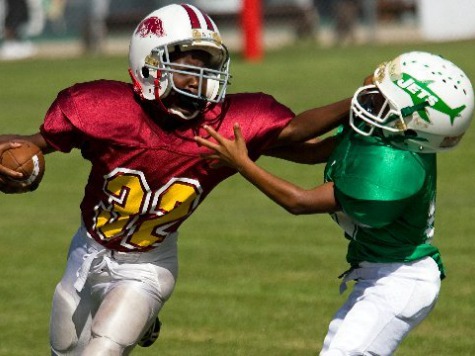Viewers of this weekend’s AFC championship glimpsed a moving pre-game vignette of the game-winning quarterback tossing the pigskin as a kid. If an Empire State assemblyman has his way, New York children aspiring to be the next Peyton Manning would face a law prohibiting them from even participating in their passion.
Michael Bennedetto has introduced legislation to ban tackle football for children under fourteen. The bill, which could subject Pop Warner coaches to fines, enjoys the support of five co-sponsors. Because nearly three-quarters of athletes participating in the sport do so at the sandlot level, the bill would ban the vast majority of tackle football played in the state.
“No child thirteen years old or younger shall play, practice, or otherwise engage in organized tackle football,” decrees the bill forwarded by the Bronx Democrat. The five-term assemblyman advanced a similar bill last year. He then justified the legislation by telling the New York Daily News, “I want to protect the children.”
But the data shows that youth football does a better job than ever of protecting the children. The latest annual report by the University of North Carolina’s National Center for Catastrophic Sport Injury Research shows that annual fatalities at all levels of the sport from on-field collisions have declined from an average of more than twenty three in the 1960s to less than four during the last decade.
Despite comprising the vast the majority of tackle football participants, youth players comprise just a tiny fraction of collision fatalities. For instance, during the decade from 2003 to 2012 a sandlot player died from a football hit every other season on average. Not only are the total youth player collision deaths dramatically lower than such fatalities among their high school and college counterparts, their fatality rate–given that there are around 3 million sandlot players competing–is dramatically lower, too. This fall, collisions killed more skateboarders in the city that Assemblyman Benedetto hails from than youth football players in all of the United States.
This year’s bill makes a point of permitting flag and touch football but draws the line at contact. “Any school, adult, or league or other entity whose purpose is to allow children to participate in football, who allows children thirteen years of age or younger to play, practice, or otherwise engage in tackle football shall be liable for a civil penalty.”
The proposed football ban isn’t a first for a Big Apple politician. More than a century ago, New York City joined Washington, DC in banning the gridiron game in its public schools. In the 1890s, both houses of the Georgia legislature passed a bill outlawing the sport after a University of Georgia fullback suffered a fatal injury. Had the deceased student’s mother not intervened to persuade Georgia’s governor to veto the legislation, football would have surely been made illegal in the Empire State of the South. More recently, a Dover, New Hampshire school board member made headlines in late 2012 when he proposed a ban on football in public schools in that community.
The bill comes on the heels of other demands to ban the game for kids. Neurosurgeon Robert Cantu, for instance, similarly calls for a ban on the game for children under fourteen years old. President Barack Obama, expanding upon comments he made last year questioning whether he’d let a hypothetical son play the game, recently told the New Yorker‘s David Remnick that he wouldn’t allow that imaginary son to play professional football.
The criticism of the game seems to be influencing public opinion. An October Marist/HBO Real Sports survey reported that a third of respondents would be less likely to allow a son to play football based upon the controversy over concussions. A Robert Morris University poll reported in November that 41 percent of respondents supported a ban on tackle football for children prior to high school.
But such a ban may prove a moot point. The most recent statistics show youth football losing about seven percent of its player population during the season before last. Some teams struggle to field the requisite number of players to compete on game day while other squads have simply gone out of existence. As Jeff Tatusko, president of the Greater 28 Youth Football League, explained to me prior to the season, “I definitely see that the numbers are dropping.” The youth football coach in the region of Pennsylvania that developed such talent as Dan Marino and Johnny Unitas informed, “We had 10 teams in the [13-year-old] league last year. We’re down to seven this year.”

COMMENTS
Please let us know if you're having issues with commenting.